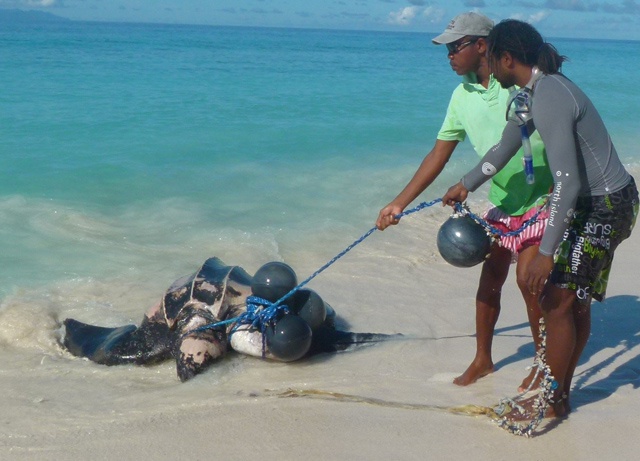Trapped turtle: Rangers rescue entangled leatherback on Seychelles' Aride island

The leatherback had to be pulled onto the beach where the necessary was done so that it was freed from the fish aggregating device. (Uzice Samedi, Island Conservation Society)
(Seychelles News Agency) - Rangers working on the Seychelles’ island of Aride worked last weekend to free a leatherback turtle trapped in a device used to attract fish.
Aride’s island manager, Uzice Samedi, explained to SNA that officials found the turtle while working to remove at least three fish aggregating devices (FADs) spotted while patrolling the island the previous day.
Samedi works for the Island Conservation Society, ICS, which manages Aride.
“The FADs were stuck on the coral reef but we could see there was something moving,” said Samedi, who has been the manager on Aride for three years.
Fish aggregating devices are floating platforms equipped with a GPS and used by the tuna purse seine industry to attract large concentrations of fish. They are commonly made up of a wide bamboo raft covered with shade material and fishing nets or ropes and fishing buoys.
The problem with the widely used commercial fishing technique is that lost or discarded FADs are often washed up onto the shore posing a threat to the coral reefs and other marine life.
“We had to drag the FAD to where the waves crash onto the shore and then cut out the ropes to free the leatherback turtle. Then we released it back into the sea,” said Samedi.
Seychelles, an archipelago of 115 islands in the Indian Ocean, provides feeding grounds for five species of marine turtles including leatherbacks. The islands are nesting grounds for only two species -- the hawksbill and green turtles.
According to Samedi the turtle was most likely a female but he could not tell properly as it was still a juvenile.
“It was a bit stressed and the colours of its carapace had faded in some areas, probably due to sun exposure, as we do not know how many days it was caught up in the FAD,” added Samedi.
 |
 |
| Once freed from its trap the turtle made it safely back to the ocean. (Uzice Samedi, Island Conservation Society) Photo License: All Rights Reserved |
Aride, which is a special reserve, is a breeding ground of millions of sea birds which in turn supports a population of skinks and other species of insects and amphibians.
It was proposed late last year that the boundaries of the island be extended to allow for more protection of its abundant marine life.
According to Uzice, the ICS team of Aride comprising of six Seychellois and two foreigners frequently encounter fish aggregating devices adding that there is still one lying between among the reefs between Aride and Praslin which they are yet to remove.
“When the sea is calm they are dragged in and get stuck among the reefs. It is our responsibility to remove them because they pose a threat to the various species of fish that get attracted to them,” said Uzice.
The Island Conservation Society, which also runs environmental and conservation programmes on other Seychelles islands, has a keen interest in the damaging effect that the FADs can pose to the marine ecosystem. This includes on Alphonse island where the non-governmental organization has been dealing with getting discarded FADs away from the reefs.
ICS also sent a delegate to the Indian Ocean Tuna Commission (IOTC) Working Party on Ecosystems and Bycatch between 7-11 September, 2015 to highlight the cleanup costs and the environmental dangers that these devices impose with representatives of the tuna fishing industry and fisheries managers.





